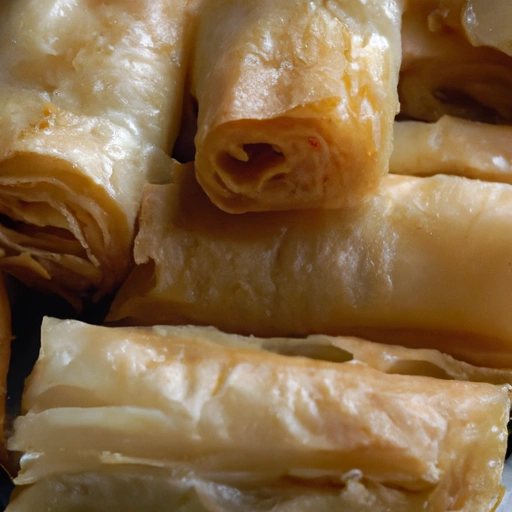Phyllo
Description

Phyllo, also known as filo or fillo, is a paper-thin unleavened dough used for making pastries in Middle Eastern and Balkan cuisines. Phyllo layers are brushed with oil or melted butter and then stacked to provide a flaky texture to dishes such as baklava and spanakopita. It is available in different thicknesses suitable for a range of recipes. In recipes, phyllo is typically measured in sheets, with the number of layers varying depending on the desired texture and recipe requirements.
Common uses
Phyllo dough is commonly used to create a variety of sweet and savory pastries. It is often found in traditional recipes for desserts like baklava and börek, a savory pie filled with cheese or meat. Additionally, phyllo is used to make tarts, turnovers, and appetizers like phyllo-wrapped asparagus or cheese-filled triangles.
Nutritional value
Calories
A typical serving of phyllo dough, which is about 2 sheets (28g), contains around 80 calories (335 kJ).
Protein
Phyllo dough contains about 1.5 grams of protein per serving.
Fat
There is approximately 1 gram of fat in a serving of phyllo dough.
Carbohydrates
Each serving of phyllo dough has around 15 grams of carbohydrates.
Vitamins
Phyllo dough contains small amounts of certain B vitamins, particularly niacin.
Minerals
Phyllo dough provides minimal amounts of essential minerals.
Health benefits
As phyllo dough is low in fat and can be used with a variety of healthy fillings, it can be part of a balanced diet. Whole wheat versions of phyllo also offer added fiber.
Potential risks
While phyllo itself is low in fat, many phyllo dishes are high in calories due to added butter or oil. It is also important for those with gluten sensitivities or celiac disease to avoid traditional phyllo, as it is made with wheat flour.
Common recipes
Phyllo dough is featured in a wide range of recipes including sweet desserts like baklava and galaktoboureko, savory pies like spanakopita and tyropita, and various types of filled pastries and appetizers.
Cooking methods
Phyllo dough can be baked, fried, or even air-fried to achieve a crispy and golden texture. It is essential to keep the unused sheets covered while working with phyllo to prevent them from drying out.
Pairing with other ingredients
Phyllo pairs well with a variety of ingredients, including nuts, honey, cheeses, spinach, and various meats. It also works nicely with custards and fruit fillings for sweet applications.
Summary
Phyllo dough is a light, flaky pastry ingredient that's deeply rooted in culinary history, with a versatility that makes it suitable for a multitude of dishes ranging from sweet to savory. Understanding its delicate nature and learning proper handling techniques can elevate many traditional and contemporary recipes. While nutritious in moderation, attention should be given to the additional ingredients used in phyllo-based dishes.